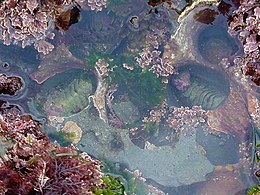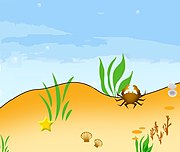
Back قاعيات Arabic Bentos Azerbaijani Бентас Byelorussian Бэнтас BE-X-OLD Бентос Bulgarian Bentos BS Bentos Catalan Bentos Czech Benthos German Βένθος Greek

| Part of a series related to |
| Benthic life |
|---|
 |
|
Benthos Benthic zone Benthopelagic (coupling) Seabed |
Benthos (from Ancient Greek βένθος (bénthos) 'the depths [of the sea]'), also known as benthon, is the community of organisms that live on, in, or near the bottom of a sea, river, lake, or stream, also known as the benthic zone.[1] This community lives in or near marine or freshwater sedimentary environments, from tidal pools along the foreshore, out to the continental shelf, and then down to the abyssal depths.
Many organisms adapted to deep-water pressure cannot survive in the upper parts of the water column. The pressure difference can be very significant (approximately one atmosphere for every 10 metres of water depth).[2]
Because light is absorbed before it can reach deep ocean water, the energy source for deep benthic ecosystems is often organic matter from higher up in the water column that drifts down to the depths. This dead and decaying matter sustains the benthic food chain; most organisms in the benthic zone are scavengers or detritivores.
The term benthos, coined by Haeckel in 1891,[3] comes from the Greek noun βένθος 'depth of the sea'.[1][4] Benthos is used in freshwater biology to refer to organisms at the bottom of freshwater bodies of water, such as lakes, rivers, and streams.[5] There is also a redundant synonym, Benton.[6]
- ^ a b Benthos from the Census of Antarctic Marine Life website
- ^ US Department of Commerce, National Oceanic and Atmospheric Administration. "How does pressure change with ocean depth?". oceanservice.NOAA.gov.
- ^ Haeckel, E. 1891. Plankton-Studien. Jenaische Zeitschrift für Naturwissenschaft 25 / (Neue Folge) 18: 232-336. BHL.
- ^ βένθος. Liddell, Henry George; Scott, Robert; A Greek–English Lexicon at the Perseus Project.
- ^ "North American Benthological Society website". Archived from the original on 2008-07-05. Retrieved 2008-08-16.
- ^ Nehring, S. & Albrecht, U. (1997). Benthos und das redundant Benton: Neologismen in der deutschsprachigen Limnologie. Lauterbornia 31: 17-30, [1].